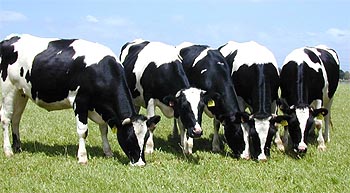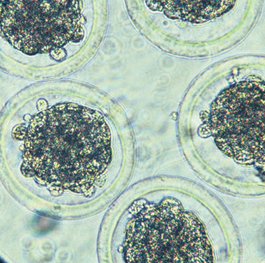
Frequently Asked Embryo Transfer Questions
We are often asked how to increase embryo survival rates.
Below are several practical strategies which can be used:
- Make sure your cattle are getting proper nutrition. Palatable dry matter containing high energy is essential, without the latter CLs on the ovaries tend to disappear before the end of the first cycle terminating the early pregnancy. This occurs especially when grass is in the spring flush. Ensure clean water and watch for algae in times of drought.
- A comprehensive vaccination program is also essential, covering the clostridia family of diseases and the respiratory complex of diseases. Plus you may have some additional diseases to cover specific to your area. Discuss this subject with your veterinarian.
- Body condition is significant, donors and recipients should not be too fat or too thin—obvious you are probably thinking, but quite frequently donors and recipients are not in the optimum condition when prepared for embryo transfer procedures. They should have a body score of around 6.
- Do not reduce feed during the embryo transfer program. I have observed frequently donors placed in a new situation with new cows and a different feeding protocol. Not only are the digestive processes upset, the donor has to establish a new peck order.
- Avoid excessive proteins. This can occur when high protein supplements are fed as an additive to an already optimum protein level.
- Make sure your heat detection methods are efficient. Remember especially in hot weather 60% of the heat signs occur at night. Poor heat detection can lead to lack of fertilization of the eggs and/or poor quality embryos. One of the most useful, efficient and economical methods of detecting standing heat is the application of a thin line of pressure pack paint on the tail head. The best colors are, fire engine red and incandescent orange. Use a can of marking spray-paint, (the type used by surveyors).
- Use high quality semen. Beware of using semen which has passed through several different operators. Our early experiments demonstrated that two inseminations using one dose of semen each time is sufficient. In fact with very valuable semen we have over the years used only one dose of semen on a superovulated donor, 20 to 24 hours after first standing heat. The last time we followed this protocol 13 number one embryos were recovered.
- Shade is essential in hot humid weather and when conditions are like this work the cattle at first light and/or just before dark. Remember in the latter case cows do not cool down until around 3am, so it is always wise to do the bulk of the cattle work just after dawn.
- If you are dealing with heifers make sure they are cycling regularly before attempting synchronizing procedures. Remember if they are Brahman/zebu crossed with Bos Taurus breeds they take longer to mature usually. Ensure the heifers are well grown if you intend to use them as recipients—there is nothing worse than pulling calves from young females with consequential mothering-up problems, low quality colostrom and sickly calves.
- Select sires carefully, bearing in mind proven production and fertility of offspring. Since we are all in this business to make a decent living a thorough knowledge of which bull on which cow will make embryos and calves popular in the market place resulting in profits.
- Good records need to be accurate and up to date. Design a system which is quick and easy especially when recording data by the chute, this is important since the person doing the recording usually has many other jobs. Since donors respond very differently to the hormone treatments used for embryo transfer it is essential to record every detail of the procedures and their outcome.
Recent Questions
Question: Since graded embryos are transferred by trained technicians, using prepared recipients why do we not always achieve optimum pregnancy rates?
Answer: In "trouble shooting" requests for help around the embryo transfer industry often the condition of the donor or even more frequently the recipients is the problem while the embryo transfer techniques are up to accepted standards. On the other hand there will be periods of frustration when nothing seems to work and one should remember we are attempting to apply 21st Century techniques to a species developed 50,000 years ago.
Question: Why do donors and recipients have to be in the right condition?
Answer: Donors are often too fat for optimum responses to our synchronizing and superovulation drugs while this condition is regarded as the choice form for show purposes. This type of donor frequently demonstrates signs of estrous behavior but do not stand, then 7 days later cystic follicles are palpated instead of the desired corpora lutea (CLs).When recipients are overweight the incidence of ovulation decreases so 7 days after heat lutein follicles are found instead of the expected CLs. I have rejected up to 50% of a group of prepared recipients due to this problem. In addition the reproductive tract in fat donors and recipients is more difficult to palpate which may lead to inefficient flushing and accurate placement of the transferred embryo in the recipient, when even identification of a CL may be difficult in fact on examination of the reason for low pregnancy rates in recipients common problems have been incorrect identification of a CL and the embryo placed in the wrong horn. A spinal block is of significant help when transferring embryos. This discussion of CLs leads to another area where again significant costs are imposed on recipient owners.
Question: Why do some embryo transfer technicians cull so many recipients?
Answer: I have observed recipients rejected because the CLs were considered too small, the wrong shape, or fluid was palpated in the CL. In the early days of embryo transfer embryos were transferred surgically under a general anesthetic after rectal palpation for a CL so we took the opportunity to measure the CLs and comment on their shape and size when the tract was exposed. We found no differences in these described CLs. A CL was called "cystic" when fluid was observed or palpated which is an unfortunate term because this type of CL is a normal phenomenon and cystic denotes a pathological condition. Our data confirms this statement with no reduction in pregnancies following embryo transfer. Relatively recently this type of CL has been designated a CL with fluid. With the significant increased costs of drugs, feed and labor unnecessary culling of recipients is costly.
Question: Why do we too frequently miss observing standing heat?
Answer: Observation and recording of standing estrus can be another area of inefficiency leading to increased costs. Removal of a calf after the last prostaglandin (e.g. lutalyse) injection will improve the incidence of standing heat. The calf can be returned to the mother as soon as standing heat is observed. Repeated suckling causes increased release of a hormone called cortisone which negatively affects the reproductive hormones. We have found a thin line of pressure pack paint ( incandescent orange or fire engine red are the best colors ) on the tailhead has proved a very efficient and reliable method of detecting standing heat, particularly useful in hot humid weather when standing heat increases at night. Incidentally many owners consider a natural heat increases the chance of a pregnancy compared to an induced synchronized heat, however our data has shown there is no difference providing a CL is present.
Question: Should we use a failed recipient a second time?
Answer: Yes, at least one more time assuming the embryos are graded 1 or 2. In one of our early experiments we implanted grade 1 or 2 embryos into crossbred beef heifers, those that failed to establish pregnancies over 3 attempts we asked the question ,did they fail because they are sterile or were they not capable of establishing a pregnancy with a transferred embryo. To clarify this question we artificially inseminated this group and after 3 attempts 88% were pregnant. So the very occasional recipient will fail due to rejection of the implanted embryo. However after one transfer a failure may be due to the embryo or due to the technician. In addition approximately $100 has been added to the cost of the recipient due to probable hand feeding, heat detection and estrus synchronization, so try her once more.
Question: Why do some donors fail to establish regular estrous cycles after flushing?
Answer:Occasionally donors are not observed for heat after collection and do not establish regular estrous cycles. After 3 superovulations some donors will produce ovarian cysts. The most common one is a lutein cyst and in this case the donor will not demonstrate heat. Early treatment is usually successful following an injection of a PG. In other cases the donor is in constant heat indicating a follicular cyst. Treatment in this situation is manual per rectal rupture plus an injection of GnRh (e.g. cystorelin).
Question: A common question is should we superovulate heifers?
Answer: Once again from our records it is possible to impose this treatment on heifers providing care is observed then future fertility is not affected. Often in the early days too much FSH was administered to the young animals and if they were in the mode to respond then ovaries could grow to the size of a grapefruit, when this occurs the ovaries are heavy prone to damage and significant hemorrhage leading to upper reproductive adhesions and subsequent infertility. Often the eggs disappear into the abdominal cavity, those that enter the oviducts often are not fertilized and the few embryos produced are of poor quality. However every so often many embryos are produced and these are the ones that become well known. Basically use conservative doses of FSH and make sure the heifer is cycling regularly even before estrous synchrony drugs are administered.
Question: After a failed superovulation treatment when can I start the donor again with a reasonable chance of success?
Answer: The optimum time is after two normal cycle lengths.
Question: When the donor exhibits heat one day earlier or later than the predicted date, should she be bred?
Answer: Yes, one day either side of the estimated date can be successful, but usually two days or more will fail.
Question: If the donor exhibits signs of heat but is not observed standing, do we breed her?
Answer: No, if the donor does not stand, breeding is not successful. However be careful in this case-she may have stood but was not observed standing e.g. 60% of cows stand during the dark a common
Occurrence during hot humid weather. In all cases heat detection aids are essential.
Question: How many times should the superovulated donor be bred?
Answer: Breed donors on two occasions using one straw per AI. First AI at first observed standing heat and the second AI approximately 12 hours later. It is not necessary to be exactly 12 hours apart. Proven quality semen used correctly is equivalent to a proven bull. Increasing doses of semen or number of times bred will not improve results.
(Kurykim, Therio.67, 754-759).
Question: How to handle sexed semen?
Answer: When using sexed semen handle with great care. In this case only use two doses of semen per AI. Experiments have shown horn breeding did not improve results.
Question: Should we breed donors coming into heat one day earlier or later than the predicted date?
Answer: Yes, our data records no difference in embryo production,however two days later than the predicted date has not been successful.
Question: If the donor exhibits signs of estrus but does not stand ,embryos have not been recovered.
Answer: In this case great care has to be taken that the donor did not stand or a stand was missed.Correct tail head marking would answer this question.
Question: When a superovulated cow exhibits heat before or after the predicted date should we still breed her?
Answer: Yes, if she is two days early or one day after the predicted date it is possible to retrieve transferrable quality embryos.
Question: If a donor shows some signs of heat at the predicted time of heat but does not stand,should we still breed her ?
Answer: Not unless she actually stands to be mounted . When they only show secondary estrous signs at the time of heat the donors usually do not ovulate. Just inject PG to initiate a new cycle .
Question: Who sells the "best" FSH? Are there "weak" or "stronger" batches of FSH?
Answer: There are no measurable differences in donor responses between batches or brands of FSH .Any small differences between FSH manufacturers or brands are eliminated by the large variable ability of cows to respond to injected FSH. We even found in controlled experiments very little difference between FSH (a small protein with a half life of only a few hours) and PMSG (a large protein with a half life of 15 days).
Embryo Transfer Flushing Techniques
I am often asked why elevate the head end of the donor? Embryos and eggs are in the tip of the uterine horn next to the utero-tubal junction. In order to wash them out the medium has to completely fill the uterus all the way to the end. In heifers and young cows the uterus is in the pelvic cavity and easily within reach for manipulation during the filling and emptying process. But in mature donor cows the uterus is frequently partly or entirely in the abdominal cavity and must be pulled back into the pelvic cavity for efficient and safe flushing. This can be accomplished by retracting the uterus by the inter-cornual ligament easily located at the base of the dividing horns, and then it must be held there during the flushing process in order to assess how full the uterus is with medium. Obviously if the donor is elevated at the front it is easier to maintain the pelvic position and the operator can estimate if the two horns are filling as required and avoid over filling and a ruptured wall of the uterus.
There are several methods of elevating the cow at the front, for example for large cows two square hay bales may be used with plywood as a platform, or a step can be placed in the squeeze chute, or you can build a sloping floor to the chute, or simply raise the front of the chute with a farm jack and then place blocks under the chute (whichever method you choose to elevate the cow, make sure it is stable in order to avoid injury). Obviously donors are flushed without this aid but elevating the head end of the donor will improve results, and in time it will help avoid rotator cuff damage in the shoulder.
Differentiating Eggs & Embryos / Grading Embryos
Often student embryologists are rightly concerned about differentiating eggs and embryos and then grading embryos. The following suggestions should be of some help. Before searching for embryos knowing the number of days after estrus is helpful. For instance, on day 6 there is the possibility of eggs and morulae (morulas ) and late on day 6 early blastocysts. On day 7 there is the possibility of eggs, morulae and blastocysts. On day 8 there is the possibility of eggs, even the occasional morula, blastocysts and expanded blastocysts. Once an embryo has been identified then it is usually graded. The International Embryo Transfer Society has advised on 3 grades: 1 is excellent, 2 is good, and 3 is fair. Grading is based on several features, for example stage of development in relation to morphology ( appearance ), color, shape, extruded cells, broken membranes et cetera, all of these factors are collated and a grade given. The reason for grading is to estimate the expected pregnancy rate so the embryo should be judged on its appearance and not what was expected. For instance following freezing and thawing the trophoblast layer of a blastocyst will frequently collapse leaving the appearance of a small, dark morula, therefore it should be graded as such. Obviously grading is subjective and in many cases there is very little difference between the success of embryos graded 1 or 2 especially between two operators.
Testimonials
"My time was well spent at The International Embryo Technology School, it was one of the best things I have ever done to date. Thus taking the course has given me a great advantage in the purebred cattle industry and an awesome outlook in the business world."
Rodney Hollman

"Just wanted to let you know how valuable your course has been for me. Your presentation of information and techniques was great! Being able to perform embryo transfer has added much value to my practice."
Jan Michler DVM

"I just wanted to say I think the tuition for your class was the best money I've ever spent for continuing education. I really appreciated the way things were presented. They left no grey areas about which methods and techniques were best."
Bruce l. Chambers DVM
"I now have calves on the ground from my ET work thanks to you. My conception rate on frozen embryos is in the 60s right now. Thank you for the schooling."
Doug Giles
"I just wanted to tell you thank you for offering such a great class, this has been a wonderful opportunity for me. Yesterday I saw my first embryo calf born and another is on the way."
Cheri Kraus

|
|
|